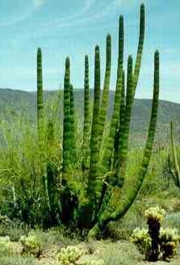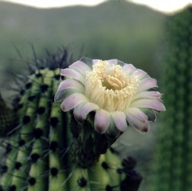

Genus: Stenocereus
Species: thurberi

The organ pipe cactus grows only in the Sonoran Desert. It is found from southwestern Arizona south to Sonora, Sinaloa and Baja California in Mexico. Organ Pipe National Monument in Arizona was created to protect the cactus in its northern most range.
Organ pipe cacti are very sensitive to frost. Because cold air settles in valleys and the desert floor, the heat loving organ pipe cactus grows on southern facing slopes below elevations of 3,000 feet.
The organ pipe cactus gets its name from the many slender, curving vertical stems which resemble the large pipes of an old-fashioned organ. Growing from a base just above the ground, the column-like stems can grow 25 feet tall, but usually grow to a height of 15 to 20 feet. The stems are about 6 inches in diameter, and rarely branch out. They have 12-17 dark-green ribs. Nine to ten brown 3/8 inch spines grow from close-set areoles on the crest of the ribs, and turn gray with age. The stems continue to grow from their tips, marking each growing season with a slight constriction around the stem.
Like the saguaro, the organ pipe cactus needs shade and protection for a few years during its seedling stages. It depends on "nurse plant" like the desert ironwood, palo verde and triangle-leaf bursage to develop. When the organ pipe cactus matures, its root system will eventually absorb any rain that falls. This deprives the nurse plant of the water it needs, and as a result it becomes stunted or dies.
The organ pipe cactus stores water in its stems to survive the heat and drought of the desert. It has fibrous ribs running vertically up the stem to help keep it upright. When the cactus dies it leaves behind its bleached ribs.

The flower buds of the organ pipe cactus grow from the tip of the stems. The flowers are white or pale lavender in color. They mostly bloom at night and are pollinated by nectar feeding bats, and by morning they close up again. The cactus has many buds which open up on different days so that the flower season can last for many weeks. They bloom annually from May to July.
The red fruits are large and spiny, and ripen in late summer. When they mature, they lose their spines and open to show an edible, red pulp. They are sweet and fleshy, and are eaten by a variety of desert wildlife. It is a favorite with people also, who eat it raw, dried or turn it into jelly. It is also made into syrup and fermented into a wine-like drink.
Native Americans ate the fruit raw or dried it for storage. The wood of the ribs was used for building and turned into torches.
The organ pipe cactus is not endangered in its range, although it is protected in the USA, where it grows only in a small section of southernwestern Arizona.
2002
Bibliography:
Organ Pipe", http://www.dbg.org/Involved/organpipe.html
"ORGAN PIPE", http://helios.bto.ed.ac.uk/bto/desbiome/organpip.htm
"organpipecactus.html", http://www.bio.gasou.edu/Bio- home/Courses/environmental/leege/BOO/ghseontheweb/desert/organpipe cactus.html
"CACTI OF SOUTHERN CALIFORNIA", http://www.halice.com/tucson/cacti.html
"Plants at Organ Pipe National Monument", http://data2.itc.nps.gov/nature/plants.cfm?alphacode=orpi&loc=2